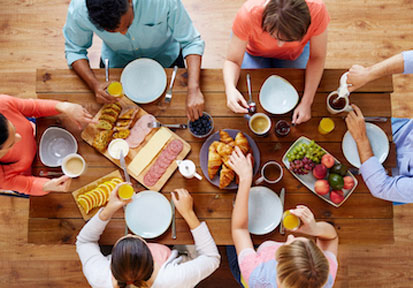You need discipline to stick to a healthy meal plan, especially when you’re trying to lose weight and reach your fitness goals. It can be tough enough to fight your own cravings and busy schedule, but it can be even harder when you throw family, friends, and social outings into the mix. So how can you stick to your meal plan, even when you’re not dining alone? The key is planning ahead, asking for support, and taking it one step at a time.
Navigate family meals
If you’re a parent, you want your family to eat healthy. But on those busy nights when you’re shuffling straight from work to after-school activities, it’s hard enough to find the time to cook, let alone make sure you’re choosing the right foods. (Hint: the key is planning!) Make healthy meals more manageable with these strategies and tips.
- Assess and plan. Before you begin meal planning, review your schedule for the week. Ask yourself: How many nights does at least one person in the family have an activity that goes until dinnertime or later? How much time is there, realistically, to prepare a meal between getting home and bedtime? Is there any time during the week when you could spend a little more time to prepare ingredients or meals in advance? Add up the number of nights you won’t have more time to make dinner and you’ll need quick meals.
- Write it out. Then with pen and paper, your favorite app, or using the 7-day meal plan template in this kit, lay out your plan. Pull out some favorite recipes to help you decide which meals will work with your schedule and which ingredients you’ll need to buy. This will help you be prepared for the busy week ahead and resolve any decision dilemmas when you’re in a rush. Once you create your grocery list, stick to it!
- Get ahead. Prepare ingredients in advance—wash and chop vegetables and fruit, mix marinades and sauces, boil eggs, and cook whole grains (such as rice and quinoa)—and toss them in the fridge or freezer to use later in the week. Also, choose items where the work is done for you (frozen veggies that are washed and chopped, frozen whole-grains that heat up quickly. Use a slow cooker to create one-pot meals in advance so you can come home to a ready meal.
- Make it a family goal. Get older kids involved with cooking or other dinnertime tasks such as boiling water, cutting vegetables, etc. Younger children can help set and clear the table. Bonus: Involving kids with meal prep builds positive life skills and relationships and teaches them responsibility.
 Succeed at social gatherings
Succeed at social gatherings
Healthy (and unhealthy) eating habits are contagious. When those around you make good (or not-so-good) food choices, you’re more likely to do the same. It can also be tough to stick to your goals when you’re out at a restaurant, at a party, or eating at someone else’s place. Your eating plan can be vulnerable to social influences, even if you don’t always realize it. To stay ahead of obstacles, when you’re looking at your weekly meal plan, be sure to note when you’ll be eating with others. Then, use these tips to stay on track.
- Have a buddy for support. Whether it’s a spouse or someone close to you, having someone support you in your healthy choices, can help you stay on track. If you’re going to be influenced by those around you, better that it’s by someone who’s on the same page.
- Communicate ahead of time. If you have special dietary needs, allergies, or preferences (vegan, vegetarian, gluten-free, etc.) consider telling the host ahead of time or offer to bring something that fits your dietary needs. By getting ahead of the situation, the host will have a chance to prepare—and you’ll help avoid an uncomfortable conversation in front of other guests.
- Get your confidence up. If you’re trying to stick to healthy choices, don’t cave to peer pressure. If it’s your day to indulge, have that extra cookie with your head held high! Just try to stay aware of what your body wants and when you’re full. Learn more about mindful eating in Challenge 5.
- Track your eating—not everyone else’s. Many people underestimate how much they’ve actually eaten when those around them are eating larger quantities. Keep a close eye on your intake as you normally would rather than look at how much you’ve eaten compared to others.
- Take control of your plate. If the situation allows it, serve yourself the portions you’d like rather than having a host or fellow guest fill your plate. If you can’t serve yourself, politely ask for the portion sizes or food choices you’d prefer.
Learn more at our “Get into Fighting Weight” guide.
